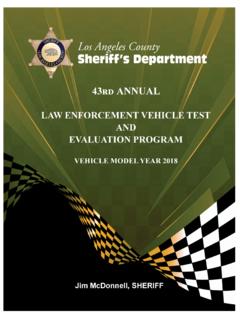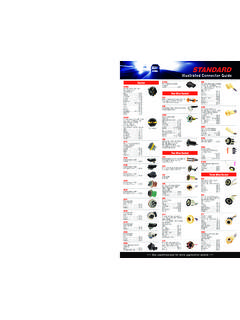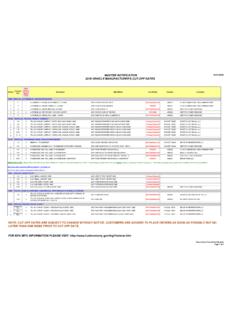Transcription of Polly Trottenberg, Commissioner, DOT Mitchell Silver ...
1 Polly Trottenberg, Commissioner, DOTM itchell Silver , Commissioner, DPRMary Bassett, Commissioner, DOHMH Local Law 38 Annual Report Fiscal Year 2017 This report details New York City s purchase of fuel-efficient light and medium duty cars (typically, cars and vans respectively). The aim of Local Law 38 (LL38) is to achieve a 25% reduction in fuel consumption by Fiscal Year 2017 as compared to baseline fuel efficiency data from Fiscal Year 2005. This drop in fuel consumption would reduce the amount of greenhouse gas being released and would also improve the city s air quality. The milestones in the legislation are as follows: October 1, 2005: The City will complete a fuel economy inventory of all light-duty vehicles purchased by the City during Fiscal Year 2005 and will calculate the average fuel economy of these vehicles.
2 July 1, 2006: Each light-duty vehicle and medium-duty vehicle that the City purchases will achieve the highest California LEV II standards. The City will also achieve a 5% increase in average fuel economy in all light duty vehicles. January 1, 2007: The City will report for the last time, whether it has complied with the Local Law standard that 80% of the light duty vehicles are alternative fuel vehicles. Following the July 2006 fuel economy milestone, the City is to achieve an increase of 8% in average fuel economy in 2007; 10% in 2008; 12% in 2009; 15% in 2010; 18% by 2012; and 20% for fiscal year 2015 and 2016, and 25% in 2017 and 2018.
3 As of Fiscal Year 2017, the City exceeded the mandated 25% increase in fuel economy for light duty vehicles. Gasoline usage by light and medium duty vehicles has decreased from 2005, but diesel consumption increased because emergency services makes greater use of the gas card program for diesel fueling. This trend does not represent total fuel use which combines in-house and gas card (private) fueling. The City exceeded the legislative goal that 95% of purchases be of the lowest polluting vehicles in their class, by purchasing 100% of the City s fleet in the lowest polluting class.
4 The answers below describe the status of the City s implementation of the law and respond to the specific questions posed in the 1. What is the total number of light-duty vehicles and medium-duty vehicles purchased by each agency? 1 Section (e)(1) of the Administrative Code sets forth seven questions to which the Annual Report is required to provide an answer. 2 Agency Light Duty Medium Duty Total Dept. of Health & Mental Hygiene (DOHMH) 101 18 119 Dept. of Environmental Protection (DEP) 103 40 143 Dept. of Transportation (DOT) 92 0 92 Dept. of Citywide Administrative Services (DCAS) & Managed by DCAS 218 13 231 Dept.
5 Of Sanitation (DSNY) 95 25 120 Dept. of Parks & Recreation (DPR) 15 13 28 Dept. of Education (DOE) 5 0 5 Total 629 109 738 NB: FDNY and PD are exempt from this reporting requirement as they are emergency vehicles. 2. What is the total number of light and medium duty vehicles purchased in each rating category, disaggregated by vehicle model? a. The total number of zero emission vehicles (ZEV) purchased; b. The total number of advanced technology partial zero emission vehicles (ATPZEV) purchased; c. The total number of partial zero emission vehicles (PZEV/TZEV) purchased; d. The total number of super ultra-low emission vehicles (SULEV) purchased; e.
6 The total number of ultra-low emission vehicles (ULEV) purchased; and f. The total number of low emission vehicles (LEV) purchased. Total ZEV Total ATPZEV Total PZEV/TZEV Total SULEV Total ULEV Total LEV Vehicle Total 99 4 302 128 205 0 738 Note: Please see Attachment A for the breakdown of the above numbers disaggregated by vehicle model. It shows that the vehicles purchased were within the highest fuel efficiency ratings. 3. How many Alternative Fuel Buses were purchased? Zero buses were purchased. 4. What is the percentage of light and medium duty vehicles purchased as the lowest polluting vehicle in each category?
7 Target of 95%. Lowest Category Other Vehicle Type 405* 0 Medium Size Sedan 66 0 Regular Size Van 123 0 Small-size Sports Utility 5 0 Mid-size Sports Utility 30 0 Light-duty Pick-ups 67 0 Medium Duty Vans 41 0 Medium Duty Pick-ups 1 0 Heavy Duty Pick-ups Total: 738* vehicles Total: 0 vehicles Total: 100% (see below) *As per (b)(2), The city shall not be required to purchase a zero emission vehicle or advanced technology partial zero emission vehicle in accordance with paragraph one of this subdivision if the only available vehicle or vehicles that achieve such a rating cost greater than fifty percent more 3 than the lowest bid as determined by the applicable procurement process for a vehicle available in the next highest rating category that meets the requirements for the intended use by the city of such vehicle or if, after consultation with the affected agency.
8 The commissioner determines that the use of such vehicle would be impractical or would unduly hinder the operations of a city agency, or if the commissioner determines that the city lacks the charging and fueling infrastructure to support use of such a vehicle, provided that the next highest rating category that meets the requirements for the intended use by the city of such vehicle shall be selected. 5. What is the average fuel economy of light duty vehicle purchases? The average fuel economy is miles per gallon. Please see Attachment B for details. 6. If a vehicle was not purchased in the highest fuel rating category, what was the basis for purchasing a vehicle in the next highest fuel rating category?
9 A waiver is needed from DEP in order to select a vehicle in the next rating category. In FY 2017, DEP issued no waivers. 7. What is the percentage increase in fuel economy? Target of 5% to 25%. The average fuel economy was , which exceeds the required reduction of 25% by Fiscal Year 2017 by obtaining a 37% increase. The baseline 2005 average fuel economy was miles per gallon. 8. What is the estimated amount of fuel consumed by motor vehicle, disaggregated by vehicle type? The chart below is based on the Gas Card System, which shows an increase in consumption of diesel since 2005. The increase in diesel use is because emergency services makes greater use of the gas card program for diesel fueling.
10 There was a decrease in gasoline consumption across the entire city fleet (light and medium duty vehicles) since 2005. 2005 Gallons of Diesel 2017 Gallons of Diesel 337,554 906,314 2005 Gallons of Gasoline 2015 2017 Gallons of Gasoline 2,828,217 2,570,704 4 9. What is the estimated total amount of equivalent carbon dioxide emitted for each type of fuel consumed by motor vehicles, disaggregated by fuel type? CO2 Calculations for LL38 Fiscal Year 2017 Year 2005 2017 Gasoline Consumed (gal) 2,828,217 2,570,704 CO2 emissions (lbs) 54,867,410 49,871, Diesel Consumed (gal) 337,554 906,314 CO2 emissions (lbs) 7,493,699 20,120, Total CO2 Emissions (lbs) 62,361,109 69, Reduction (lbs) NA (7, ) Reduction (%) NA ( ) 5 Attachment A Emissions Ratings on City Requirements Contracts for Fiscal Year 2017 * As per (b)(2)














